September 29th, 2023
“The Gates” by Christo and Jeanne-Claude, 2005
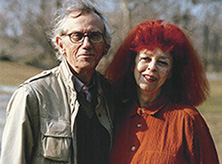 In the fall of 1979, after having served as Commissioner Gordon Davis’s first Central Park Administrator for only a few months, I was invited to attend a meeting in the Department of Parks conference room on the third floor of the Arsenal at Fifth Avenue and 64th Street. When I arrived I was introduced to the artist Christo and Jeanne-Claude, his wife and business partner in the execution of highly publicized displays involving the wrapping of mega-bolts of tough semi-transparent material around such world-famous architectural icons as the Pont Neuf (Paris, 1985), the Arc de Triomphe (Paris, 2021 and the Reichstag (Berlin, 1995). What I was now about to hear was an extraordinary proposal for a signature Christo art installation that would consist of a single 25-mile-long procession of saffron-colored banners marching through the world’s most famous park.
In the fall of 1979, after having served as Commissioner Gordon Davis’s first Central Park Administrator for only a few months, I was invited to attend a meeting in the Department of Parks conference room on the third floor of the Arsenal at Fifth Avenue and 64th Street. When I arrived I was introduced to the artist Christo and Jeanne-Claude, his wife and business partner in the execution of highly publicized displays involving the wrapping of mega-bolts of tough semi-transparent material around such world-famous architectural icons as the Pont Neuf (Paris, 1985), the Arc de Triomphe (Paris, 2021 and the Reichstag (Berlin, 1995). What I was now about to hear was an extraordinary proposal for a signature Christo art installation that would consist of a single 25-mile-long procession of saffron-colored banners marching through the world’s most famous park.
Looking out the window at the familiar scene of the pathway from 59th Street to the entrance of the Central Park Zoo, I listened with a combination of anxiety and awe as Jeanne-Claude interpreted the contents of the drawings by Christo that were being displayed on the conference table. As she spoke I suddenly recollected having been seated next to Christo at a recent dinner designed to promote “The Gates” to people who were involved with cultural not-for-profit organizations (My husband Ted was chairman of the board of the New York City Ballet at the time). I had listened intently as Christo described the story of Running Fence, in Sonoma and Marin Counties, California, which was composed of 2,050 eighteen-foot-high panels of heavy woven nylon attached to steel stanchions traversing fifty-nine privately owned ranches between U.S. Highway 101 and the Pacific Ocean near Bodega Bay. What still stands out in my mind is Christo’s blow-by-blow recapitulation of prior meetings with various government agencies and courts of law in order to procure the permissions necessary to forge an actively aesthetic relationship with the land irrespective of its political and geographical boundaries.
Strangely, Christo appeared to enjoy the endless series of hearings that forced him to face the relentless skepticism of officials at all levels of government. With his satisfaction regarding the details of the demands successfully met lingering in my mind after dinner, I came to the conclusion that Christo’s work was actually an extended piece of performance art, the lowering of the curtain on Act One being the culmination of the step-by-step process involving numerous government-agency and institutional reviews.
Although land art as pioneered by Robert Smithson and then by Christo had consensually entered the cultural domain in which individual objects of beauty crafted by human hands in the traditional media of paint, pencil, ink, and chalk on canvas and paper and figures modeled in clay or terra cotta, carved from stone, or cast in malleable metal, Christo’s artistry could best be compared with that of the stage manager of a theater. When the members of audience arrived they became the actors in a play in which harnessed space of dramatic dimensions on a site of preexisting fame became the artwork in its totality.
The curtain or, in this case, a multiplicity of curtains, could not yet be raised without the theater owner’s ok, and it was New York City as represented by Parks
Commissioner Gordon Davis, who was being addressed as the official surrogate authority for Mayor Edward I. Koch. As I saw it, my contribution to the meeting was to play the role of Central Park landscape design historian and question whether the 24 1/2-miles of supporting stanchions on either side of Olmsted and Vaux’s pedestrian circulation system would leave unsightly holes in the ground. “Don’t worry,” said Jeanne-Claude, “We have already asked our Chief Engineer and Director of Construction Vince Davenport who is behind every technical detail in all our projects to take care of this. Jonita, his wife, is officially our project manager, and she makes sure that everything is always done perfectly. So every question you have about that, ask them, not us.” Christo added, “Actually, there would be no Gates if Jonita and Vince were not here. And they will make sure that any holes left in the ground after The Gates comes down will be filled with clean dirt.”
“What is clean dirt? I asked myself and the landscape historian inside of me replied, “Just the previously dug soil for the stanchions and not anything like the rich fertile soil that was originally imported from various agricultural properties in vicinity of New York in order to grade the ground plane surrounding the park’s rock outcrops into the meadows and dells that give the park its undulating topographical variety.” The obvious alternative to Davenport’s construction crew shoveling in “clean dirt” into empty holes would have been for the current Central Park horticultural crew to bring composted soil from the pile of organic debris that is turned into friable soil atop the park site known by its pre-park name as The Mount. The creation of this onsite permanent supply of organic compost for distribution to enrich new planting throughout the park was a priority project of the newly incorporated Central Park Conservancy at this point. The Mount, as the site next to the East Drive opposite 103rd Street continues to be called, occupies the site of what was once a brick chapel and refectory for the boarding school run by the sisters of the convent of St. Vincent. Fertilizing floral borders and the sites of newly planted shrubs and trees is one of the ways in which the Central Park Conservancy practices the art of horticulture, and I was ready to leave the argument of what constitutes “clean dirt” for another day. I was moreover pleased when Gordon whispered in my ear, “I need to make the case for the park being an original work of land art and that fulfilling the goals of the restoration plan your staff has started working on should take precedence over decorating the park for no intrinsic reason. Still, the meeting was not a forum for debate with Christo and Jeanne-Claude on any grounds, and what mattered most to me at this point was Gordon’s all-out support of the simple mission statement of the embryonic conservancy, “To make Central Park clean, safe, and beautiful.” That he valued my use of the word “beautiful” and my association of it with the fact that, in addition to initiating a system of more efficient garbage collection and instituting an urban park ranger patrol to ensure obedience to park rules and forestall acts of danger, the aesthetics Central Park was for him a key determination for his emphasis on caring for it as one of the greatest of New York City’s historic landmarks as well as a world-famous urban icon. Verbatim evidence of this can be found in his final version of the document constituting the Park Department’s summary and determinations for refusing to issue a permit for the three-week exhibition of The Gates in Central Park.
Summary
Public art in the conventional sense is sculpture, painting, or ornament that decorates, adorns, enlivens and often humanizes architectural space. Broaden the definition and public architecture and landscape architecture are themselves forms of public art. The Brooklyn Bridge, Grand Central Station and Central Park are such works of public art.
The proposed exhibition of Christo’s 11,000 to 15,000 gates arching over 25 miles of Central Park’s pathways is also public art on a public works scale. Whether in the context of Central Park, or imagined in another, say for instance, the entire shore rimming Manhattan Island, the multitude of banner-hung gates appeals in almost the same way that a convocation of tall ships appeals to us: as a festive, celebratory, not-to-be-forgotten event. But what does a Christo happening, however magical and transitory, mean to Central Park?
Inspired by England’s landscaped gardens and Olmsted’s urbanized Jeffersonian philosophy, Central Park is an expression of America’s artistic, engineering and political genius. It is, to the surprise of some people, completely man-made. For many years politicians and a Parks Department that were indifferent to park preservation allowed its grandeur as a practical, poetical, and artistically conceived naturalistic landscape for passive as well as active recreation allowed this indispensable outdoor second home for New Yorkers and primary item of tourists’ lists of must-see features of the city along with such obvious ones as the Statue of Liberty, the Empire State Building, and Times Square.
Today, resident New Yorkers and out-of-town visitors alike shun Central Park because its reputation has become not one of outdoor urban pleasure but rather a semi-wasteland defaced by graffiti, a drug dealers’ market, and a prime location for opportunistic thefts by muggers.
How the park is used or should be used, the manner in which it is, or is not, preserved as a unique historic landscape and the priority given to such efforts required this Report’s extensive consideration of Central Park’s early and contemporary history, its design and restoration, and how it has been and will be used in the part, the present, and the future. These are the subjects which Christo has treated minimally or not at all. As the artist in this instance he was free to do so without being cast out as subversive. For the Parks Department to follow suit surrounded as it is with the terrible consequences of such past failures of vision and comprehension, would be tragic.
Determination
We have concluded that The Gates must be declined; the project is, after all, in the wrong place at the wrong time and in the wrong scale. In addition, it is important to note that Christo’s proposed period (the last two weeks in October) would occur, in part, during the same time as the preparation for and the running of the New York City Marathon, which is held each year on the next to last weekend in October. The Marathon is, or course, one of the Park’s largest events.
_
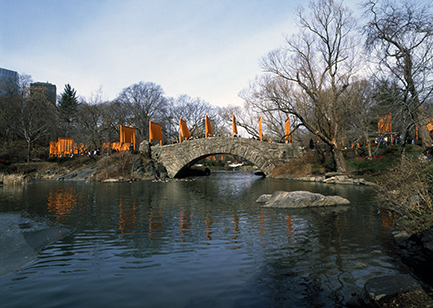
As already evident from the histories of their previous projects, part of their popular success was in the newsworthy waiting game in which Christo and Jeanne-Claude never took “no” for an answer and instead continued to keep the permission process alive as ongoing publicity while exhibiting drawings in several art galleries and banking the proceeds from their sales into a growing account that would eventually total the budgeted amount for the cost of fabricating , installing, and monitoring the public display of The Gates. This would not occur until 2005 during the mayoral administration of Michael Bloomberg, and when his support of the project was announced, I knew better than to take issue with New York City’s best mayor since Fiorello La Guardia and a longtime Central Park Conservancy supporter. Besides, it suddenly dawned on me that The Gates would have a celebratory aspect if one linked their appearance in the park to the fact that the year 2005 marked the Conservancy’s twenty-fifth anniversary. In addition to this, with Gordon’s resignation from the office of Parks Commissioner in April, 1983, the legal brief he had authored in 1980 with the participation of some of his staff members, including me, was no longer effectual.
_
The Central Park Conservancy’s success story has been told elsewhere, and here it will suffice to say that I now enjoyed my behind-the-scenes presence following The Gates from the stage of artist’s dream to fabrication, installation, and attraction for four million visitors during its two-week run from February 12th through February 28th, 2005.
With my established relationship with Christo and Jeanne-Claude and acquaintance with Vince Davenport, I could take note of the meticulous logistics behind the entire project. Doug Blonsky, who was at the time the Central Park administrator and president of the Central Park Conservancy, worked closely with Davenport throughout each phase of the installation of the 7,503 gates, including the exact placement of the steel footings that had be cast for each of the rigid three-sided sixteen-foot-high vinyl frames that supported the fabric panels. Their exact placement was of critical importance, and I was relieved to discover on one of my regular daily walks in the park that on either side of the path there was a small stenciled green maple leaf marking the exact spot where a steel footing would be placed. The point of this was both to ensure proper spacing and avoid the interference of a series of “gates” wherever there were trees adjacent to paths.
_
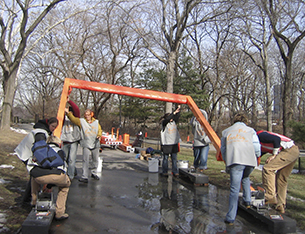 The workforce that accomplished the entire feat of erecting and dismantling the gates as well as monitoring each one on site was made up of volunteers recruited by Jeanne-Claude who managed a large online directory of applicants that included many who had been involved in earlier Christo projects. Once onboard, the volunteers were organized as teams and systematically assigned on a daily basis by trained leaders to specific areas within the park. Before they were thus dispatched each morning they would have been greeted by Christo and Jeanne-Claude and served coffee at the Central Park Boathouse Café.
The workforce that accomplished the entire feat of erecting and dismantling the gates as well as monitoring each one on site was made up of volunteers recruited by Jeanne-Claude who managed a large online directory of applicants that included many who had been involved in earlier Christo projects. Once onboard, the volunteers were organized as teams and systematically assigned on a daily basis by trained leaders to specific areas within the park. Before they were thus dispatched each morning they would have been greeted by Christo and Jeanne-Claude and served coffee at the Central Park Boathouse Café.
_
Three sets of volunteers were organized according to the days of the gate’s erection, on-site display, and de-installation. Those who stood duty as monitors once the gates were in place held long poles, each crowned by a tennis ball, which served as a means of flipping any breeze-blown banner back in place with one quick jump in the air. Monitors also played the role of hospitable hosts, offering each person walking along the path beneath the banners a two-inch wide sample of the saffron fabric from which they were made.
I too became a daily visitor and was able to enjoy nature’s cooperation in providing different weathers as varying contexts for this unconventional art exhibition. The popular response to a mild snowstorm that lasted for two days was evident in the long strings of footprints on the snow-blanketed paths where visitors walked amid the “gates.”
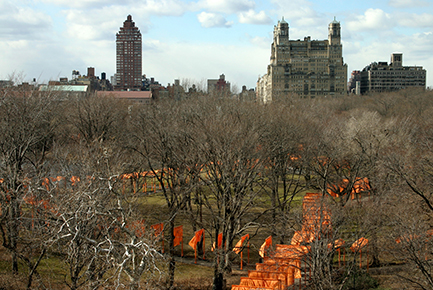 The locations where I walked were random ones throughout the park. Most of the time I would find myself climbing to the top of a rock outcrop and appreciating what I believe to be the park’s greatest design asset: its grade-separated circulation system of carriage drives, bridle trail, footpaths, and sunken cross-town transverse roads. Looking down from a Manhattan schist perch the curvilinear character of the pedestrian path system was highlighted by the banners defining their gracefully sinuous routes. My primary reaction was realization of the fact that the gates were an onsite accentuation of the lines that appear on the park’s original 1857 Greensward Plan. This, and the general gracefulness of the scene gave me a sense of pleasure in what I considered to be a temporarily forged friendship between Christo Vladimirov Javacheff and Frederick Law Olmsted.
The locations where I walked were random ones throughout the park. Most of the time I would find myself climbing to the top of a rock outcrop and appreciating what I believe to be the park’s greatest design asset: its grade-separated circulation system of carriage drives, bridle trail, footpaths, and sunken cross-town transverse roads. Looking down from a Manhattan schist perch the curvilinear character of the pedestrian path system was highlighted by the banners defining their gracefully sinuous routes. My primary reaction was realization of the fact that the gates were an onsite accentuation of the lines that appear on the park’s original 1857 Greensward Plan. This, and the general gracefulness of the scene gave me a sense of pleasure in what I considered to be a temporarily forged friendship between Christo Vladimirov Javacheff and Frederick Law Olmsted.
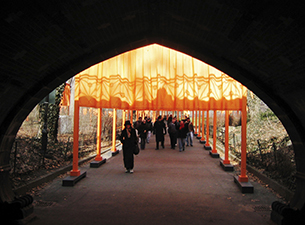 At the end of two weeks, the exhibition of The Gates, which had been ceremonially opened by Mayor Michael Bloomberg on February 12 and was scheduled to be over by February 27, had to be closed to the public. This entailed the disassembly and removal of the 7,503 gates and their saffron banners running alongside twenty-three miles of pedestrian paths, a job that was undertaken by the same well-organized groups of volunteers that had fit together the steel footings, vinyl-reinforced stanchions, and vinyl-coated saffron banners that had been designed and fabricated according to the specifications of Christo and Jeanne-Claude’s fulltime art-project-construction engineer Vince Davenport. Holding a monitor’s gift of a visitor souvenir of saffron fabric in my hand, I would periodically watch this process during the two days in which these parts were collected and then piled into waiting flatbed trucks that stood nearby on the East and West Drives. I was not alone as one of several passersby taking a last look at The Gates would stop and, like me, accept a scrap of saffron fabric from one of the monitors who were still on duty. I heard one say, “I was glad to see them come and am glad to see them go; now we have the park back.” I thought to myself, “But Central Park has never gone away but only been inscribed in a palimpsestic manner by a ceremonial saffron blaze that will keep alive the memory of its temporarily gilded face as a celebration of its innate grandeur as a work of art in its own right.”
At the end of two weeks, the exhibition of The Gates, which had been ceremonially opened by Mayor Michael Bloomberg on February 12 and was scheduled to be over by February 27, had to be closed to the public. This entailed the disassembly and removal of the 7,503 gates and their saffron banners running alongside twenty-three miles of pedestrian paths, a job that was undertaken by the same well-organized groups of volunteers that had fit together the steel footings, vinyl-reinforced stanchions, and vinyl-coated saffron banners that had been designed and fabricated according to the specifications of Christo and Jeanne-Claude’s fulltime art-project-construction engineer Vince Davenport. Holding a monitor’s gift of a visitor souvenir of saffron fabric in my hand, I would periodically watch this process during the two days in which these parts were collected and then piled into waiting flatbed trucks that stood nearby on the East and West Drives. I was not alone as one of several passersby taking a last look at The Gates would stop and, like me, accept a scrap of saffron fabric from one of the monitors who were still on duty. I heard one say, “I was glad to see them come and am glad to see them go; now we have the park back.” I thought to myself, “But Central Park has never gone away but only been inscribed in a palimpsestic manner by a ceremonial saffron blaze that will keep alive the memory of its temporarily gilded face as a celebration of its innate grandeur as a work of art in its own right.”
Share
